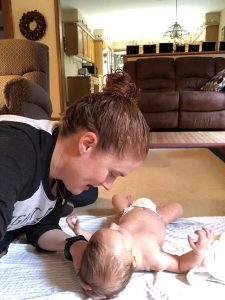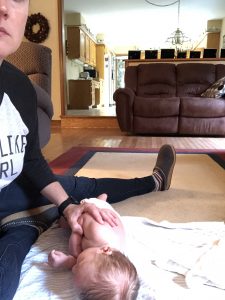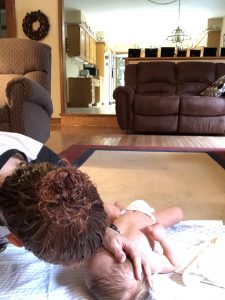I wanted to write this post and shoot this video because I often hear from families that they have a hard time doing the stretches with their babies who have torticollis or a position preference. I thought I would share some of the tips and tricks we use when we work with the babies.
I want to be clear (and I say this multiple times in the video), this isn’t to be implemented on your own. It is to help you implement the exercises that your PT or doctor has shown you for helping your baby. Please talk to them about these ideas!
These tips are to help with passive stretching or movement of the head and neck. I will work on another post to give ideas for active movement!
Generally the two movements we are looking to stretch in a babies neck are: head turning, and head sidebending (bringing their ear closer to their shoulder). These actions may be done when there is a muscle tightness or they can be done when your baby is showing a preference for one position (such as turning the head to the right) so that the muscles don’t become tight. The reason that we focus on these two motions is because these are the movements that the sternocleidomastoid (SCM) muscle perform. This is the muscle that can become tight when a baby has torticollis or spends too much time with their head in one position (such as turning their head to the right). I have talked a little bit about positional preferences in this post. The SCM can be a tricky muscle because it does these two motions but to opposite sides. So for instance if it is turning the head to the right, it is sidebending the head to the left. And vice versa!

When I am working with a baby on their back, I like to bring my face right down to their level. It helps to engage them and distract them from the movements I am doing.
For sidebending when they are on their back, I gently cup their head and slowly move it to one side. If they resist at all I stop moving and just chat away with them until they relax again and then I keep moving. Depending on what your PT has recommended I will hold them for a short period of time with their ear near their shoulder, or I will slowly move them to the other side. When I hold I am working on stretching, and when I just move through the range I am working on maintaining the muscle length and movement to prevent tight muscles.


For rotation/head turning when they are on their back, I will get in the same position and gently try to turn their head so they are looking to one side. Again, if they resist, I follow the same steps as above. And, I am down at their level making eye contact and talking to them to distract them. Another trick for rotation is to start them on their side, and gently hold their head still (GENTLY) while you let their body roll back onto their back. You can see this in the pictures above. This way you are letting gravity do the work! Just remember, do not force the movements.

For rotation/head turning while they are on their stomach, I will either turn their head while they are in tummy time (and make sure that I am on the floor making eye contact with them), or I will have them lie on my chest (so much more fun for them and me) or use the carrier. I just make sure I focus on turning in the direction the PT has recommended or I make sure they spend equal time with their head in either direction.
What are some tips and tricks you use for making it a little easier to work on passive movement of the head and neck?